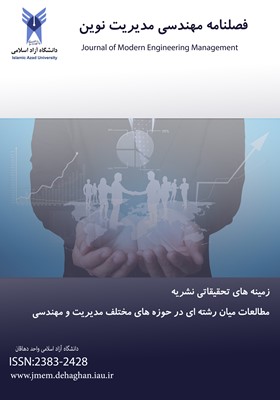کنترل بهینه پویایی مشتری از روش یادگیری ماشین با هسته چندجملهای
محورهای موضوعی : مدیریت صنعتیسید حمید عمادی 1 , ابوالفضل صادقیان 2 , مژده ربانی 3 , حسن دهقان دهنوی 4
1 - دانشجوی دکتری، مدیریت صنعتی(تولید و عملیات)، گروه مدیریت، واحد یزد، دانشگاه آزاد اسلامی، یزد، ایران
2 - استادیار، گروه مدیریت صنعتی، واحد یزد، دانشگاه آزاد اسلامی، یزد، ایران. (نویسنده مسئول)
3 - استادیار،گروه مدیریت صنعتی، واحد یزد، دانشگاه آزاد اسلامی، یزد ، ایران.
4 - دانشیار،گروه مدیریت صنعتی، واحد یزد، دانشگاه آزاد اسلامی، یزد ، ایران.
کلید واژه: کنترل بهینه, پویایی مشتری, یادگیری ماشین, هسته چندجملهای,
چکیده مقاله :
در این پژوهش، یک مدل از کنترل بهینه برای پویایی مشتریان براساس سیاستهای بازاریابی به عنوان یک سیستم غیر خودکار از معادلات دیفرانسیل مورد بررسی قرار میگیرد. هدف اصلی مدل پیگیری و تحلیل رفتار تغییرات همزمان مشتریان منظم، ارجاعی و بالقوه شرکت از زمان شروع تا به اکنون است. پیادهسازی یک سیاست بازاریابی موثر برای بهینهسازی این تغییرات و افزایش تعداد مشتریان از اهمیت ویژهای برخوردار است. در راستای این هدف، یک الگوریتم جدید یادگیری ماشین نظارتی را برای شبیهسازی عددی مسئله ارائه شده است. الگوریتم پیشنهادی از هستههای چندجملهای استفاده میکند. هستههای چندجملهای این امکان را فراهم میآورند که تابعی پیچیده از دادهها را به گونهای شبیهسازی کنند که به درک بهتر پویایی مشتریان کمک کند. رگرسیون بردار پشتیبان کمترین مربعات، یک روش بهینهسازی ساده برای استراتژیهای بازاریابی ارائه میدهند که با این رویکرد، میتوان استراتژیهای بازاریابی را بدون پرداختن به جزئیات مربوط به هر مشتری بهینه کرد و به جای آن تمرکز را بر اثر کلی این استراتژیها بر روی مجموعه مشتریان گذاشت. این تحقیق نشان میدهد که چگونه تکنیکهای یادگیری ماشین میتوانند در حل مسائل پیچیده مدیریت و بازاریابی کمککننده باشند. با گذر زمان، تعداد مشتریان منظم افزایش مییابد و افراد مشتریان بالقوه کاهش مییابند. اما، تعداد مشتریان ارجاعی نشان دهنده یک رشد سریع در ابتدای دوره زمانی و وجود یک الگوی افزایشی نوسانی در ادامه زمان است.
Purpose: This study develops an optimal control model to investigate customer dynamics with a focus on marketing strategies. The use of differential equations reflects that the model considers a non-autonomous system. The primary objective is to analyze the behavior and transitions among different customer groups, including permanent, referral, and potential customers. The research emphasizes the importance of implementing effective marketing strategies to enhance the overall number of customers and improve their dynamics.
Methodology: In this study, a novel supervised machine learning algorithm based on polynomial kernels is employed. These kernels enable accurate modeling of complex functions from data, thereby enhancing our understanding of customer dynamics. Moreover, the Least Squares Support Vector Regression (LSSVR) technique is utilized to offer a simplified and effective optimization method for marketing strategies. This approach comprehensively addresses the optimization of strategies by assessing their overall impact on the customer base.
Findings: The results reveal that over a one-year period, the number of permanent customers increases, while the population of potential customers declines. Referral customers exhibit a sharp initial growth followed by a fluctuating yet overall positive trend throughout the analysis period.
Originality/Value: This research demonstrates how advanced machine learning techniques can address various challenges in the fields of management and marketing. It shows how these technologies can significantly contribute to understanding and implementing optimal strategies across a wide range of organizations and industries
Bakshizadeh, Nastaran, Azimi, Parham. (2019). Optimization of a supply chain network using the simulation technique and Harmony Search algorithm. Industrial Management Studies, 17(54), 67-109. https://doi.org/10.22054/jims.2019.2247.1069.
Berman, B. (2016). Referral marketing: Harnessing the power of your customers. Business Horizons, 59(1), 19-28.https://doi.org/10.1016/j.bushor.2015.08.001.
Castillo, A., Benitez, J., Llorens, J., Luo, X. R. (2021). Social media-driven customer engagement and movie performance: Theory and empirical evidence. Decision Support Systems, 145:113516. https://doi.org/10.1016/j.dss.2021.113516.
Foroudi, P., Gupta, S., Sivarajah, U., & Broderick, A. (2018). Investigating the effects of smart technology on customer dynamics and customer experience. Computers in Human Behavior, 80, 271-282. https://doi.org/10.1016/j.chb.2017.11.014.
Islam, S., Amin, S. H., & Wardley, L. J. (2024). A supplier selection & order allocation planning framework by integrating deep learning, principal component analysis, and optimization techniques. Expert Systems with Applications, 235, 121121. https://doi.org/10.1016/j.eswa.2023.121121.
Ledro, C., Nosella, A., & Dalla Pozza, I. (2023). Integration of AI in CRM: Challenges and guidelines. Journal of Open Innovation: Technology, Market, and Complexity, 9(4), 100151. https://doi.org/10.1016/j.joitmc.2023.100151.
Li, X., Zhuang, Y., Lu, B., & Chen, G. (2019). A multi-stage hidden Markov model of customer repurchase motivation in online shopping. Decision Support Systems, 120, 72-80. https://doi.org/10.1016/j.dss.2021.113516.
Lyutov, A., Uygun, Y., & Hütt, M. T. (2019). Managing workflow of customer requirements using machine learning. Computers in Industry, 109, 215-225. https://doi.org/10.1016/j.compind.2019.04.010.
Mehrkanoon, S., & Suykens, J. A. (2015). Learning solutions to partial differential equations using LS-SVM. Neurocomputing, 159, 105-116. https://doi.org/10.1016/j.neucom.2015.02.013.
Mehrkanoon, S., Falck, T., & Suykens, J. A. (2012). Approximate solutions to ordinary differential equations using least squares support vector machines. IEEE transactions on neural networks and learning systems, 23(9), 1356-1367. https://doi.org/10.1109/TNNLS.2012.2202126.
Mosaddegh, A., Albadvi, A., Sepehri, M. M., & Teimourpour, B. (2021). Dynamics of customer segments: A predictor of customer lifetime value. Expert Systems with Applications, 172, 114606. https://doi.org/10.1016/j.eswa.2021.114606.
Ortakci, Y., & Seker, H. (2024). Optimising customer retention: An AI-driven personalised pricing approach. Computers & Industrial Engineering, 188, 109920. https://doi.org/10.1016/j.cie.2024.109920.
Pakniyat, A., Parand, K., & Jani, M. (2021). Least squares support vector regression for differential equations on unbounded domains. Chaos, Solitons & Fractals, 151, 111232. https://doi.org/10.1016/j.chaos.2021.111232.
Parand, K., Hasani, M., Jani, M., Yari, H. (2021). Numerical simulation of Volterra–Fredholm integral equations using least squares support vector regression. Computational and Applied Mathematics; 40:1-5. https://doi.org/10.1007/s40314-021-01471-0


